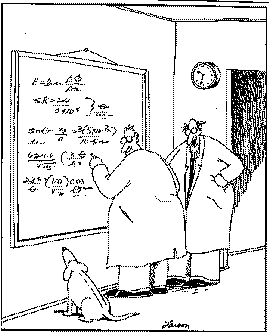 March 15, 2000
March 15, 2000
QUANTUM MECHANICS
| Physics D12-2
- Jan 6 to March 9
|
Winter Quarter 2000 |
| TTh 2:30-4:00 in Tech F328
|
Predrag
Cvitanovic' |

|
|
They are so cute when they try to understand Quantum Mechanics.
|
www.phys.nwu.edu/~predrag/NUcourses/D12-2-2000/index.html
NU Registrar course description
http://now.nwu.edu/registration/owa/
For people following the course, check the
e-mail list.
PROBLEM SETS:
Please deliver solutions to problem sets by Thursday, at the
lecture, or place them in Yueheng Lan's Physics & Astronomy mailbox
(y-lan@nwu.edu).

-
Feynman's Formulation of Quantum Mechanics
-
Schrödinger's Wave Equation
-
QM Amplitudes as a Sum over Paths
-
Classical Limit
Suggested reading:
-
Predrag's lecture notes (postscript gzipped) -
-
Chapter 1: Path Integrals
-
Merzbacher:
Sect 8.7 - The equation of Motion
-
Merzbacher:
Chapt 14 - Linear Vector Spaces
Further (optional) reading:
-
Brown: Chap 1 - Functional integrals
(Very clear)
-
R.P. Feynman and A.R. Hibbs:
Chaps 1-3
(get it from the horse's mouth)
-
Schulman:
Chaps 1-3
(standard reference on QM path integrals)
Exercises:
-
Problem set 1,
tex file,
due January 20, 2000
-
WKB approximation
Suggested reading:
-
Predrag's lecture notes (postscript gzipped) -
-
Chapter 2: WKB approximation
-
Merzbacher: chapter 7
Further (optional) reading:
-
Griffiths: chapter 8
(I like it better than Merzbacher version)
-
Symmetry in QM
-
Spherically symmetric potentials
-
Angular momentum & rotational symmetry
-
Spherical harmonics
Suggested reading:
-
Merzbacher: chapter 9
-
Andrew Jackson:
Quantum Mechanics explained
-
Comments and supplementary topics on Liboff's text.
[27 January 2000]
-
Chapters 1 to 8: general stuff
-
Chapters 9 to 12:
central forces, angular momenta
-
Predrag's lecture notes (postscript gzipped):
-
Chapter 3:
Discrete Fourier transform
-
Appendix A:
Group theory
Exercises:
-
Problem set 2:
Merzbacher exercises 7.2, 7.3
-
due February 8, 2000
Exercises:
-
Problem set 3:
Angular momentum,
- due February 17, 2000
-
Wave Mechanics
-
One- and two-body problems
-
Coulomb field: hydrogen atom
-
Angular momentum
Suggested reading:
-
Merzbacher: chapter 10
Exercises:
-
Problem set 4:
Spherical well
- due
February 29, 2000
-
Time independent perturbation theory
-
Bound state perturbation theory
-
Degenerate perturbation theory
-
Zeeman & Stark effects
Suggested reading:
-
Merzbacher: chapter 17
Exercises:
-
Problem set 5:
Time independent perturbation theory
- due
March 2, 2000
-
Group theory for QM
-
Linear momentum & translational symmetry
-
Groups, representations, tensors, reducibility
-
S0(3) rotational symmetry, and its representations
Further, optional reading:
(Read only for your own ediffication, not needed for any exams. This
is a rather idiosyncratic presentation of the theory, I am curious
to what extent you find it accessible)
-
Predrag's draft manuscript
(postscript gzipped):
-
Chapter 1:
Introduction
-
Chapter 2:
Preview
-
Chapter 3: Invariants and irreducibility
-
Perturbation theory applied to hydrogen
-
Spin - orbit coupling
-
Fine structure of hydrogen
Suggested reading:
-
Merzbacher:
section 12.1,
section 12.4,
section 16.6
section 17.6
-
A. Jackson:
Chapters 9 to 12:
central forces, angular momenta - pages 59-64, 77-86.
-
Variational methods
Suggested reading:
-
Merzbacher:
sections 8.9, 17.8, 17.9
-
A. Jackson:
Chapters 9 to 12:
Helium - pages 92-94.
Final exam
Syllabus for the final exam.
Midterm exam
mean score: 30 points out of 43 possible
Scores: 6, 21, 24, 25, 28, 29, 31, 32, 32, 34, 35, 36.
Problems sets
mean score: 181 points out of 220 possible
Scores: 202, 199, 194, 194, 193, 193, 192, 186, 179, 151, 145, 145.
Final exam
mean score: 26 points out of 38 possible
Scores: 14, 15, 23, 24, 26, 26, 28, 29, 30, 31, 33, 34.
Overall course grade
is determined from the homework (40%), midterm (20%), and the final (40%).
Grades: C, B, B, B, B, B, A, A, A, A, A+, A+.
References
-
Quantum Mechanics, E. Merzbacher (John Wiley, 1990).
-
Quantum Mechanics and Path Integrals,
R.P. Feynman and A.R. Hibbs
(McGraw-Hill, New York 1965).
-
Techniques and Applications of Path Integration,
L.S. Schulman
(Wiley, New York, 1981).
-
Quantum Field Theory,
L.S. Brown
(Cambridge University Press, Cambridge 1992).
-
Introduction to Quantum Mechanics,
D.J. Griffiths
(Prentice-Hall, Englewood Cliffs, New Jersey, 1994)
-
Quantum Mechanics, 3 ed., Vol. 3, L. Landau & I. Lifshitz, Pergamon
Press (1977).
-
Lectures on Quantum Mechanics, G. Baym, Benjamin/Cummings Pub. Co.
(1969).

![]() March 15, 2000
March 15, 2000

![]()
![]()